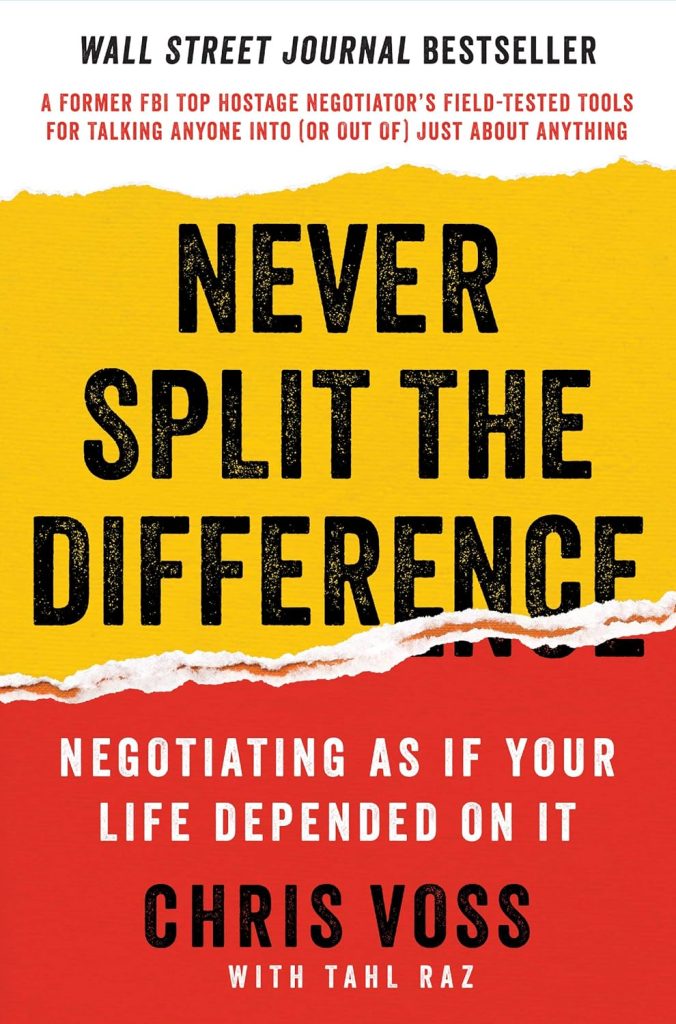
Buy The Book
Chapter
- ✦ Chapter 1: The New Rules
- ✦ Chapter 2: Be a Mirror
- ✦ Chapter 3: Don’t Feel Their Pain, Label It
- ✦ Chapter 4: Beware “Yes”—Master “No”
- ✦ Chapter 5: Trigger the Two Words That Immediately Transform Any Negotiation
- ✦ Chapter 6: Bend Their Reality…
- ✦ Chapter 7: Create the Illusion of Control
- ✦ Chapter 8: Guarantee Execution
- ✦ Chapter 9: Bargain Hard
- ✦ Chapter 10: Find the Black Swan
Never Split the Difference: Negotiating As If Your Life Depended On It
About
“Never Split the Difference,” penned by Chris Voss, a former FBI hostage negotiator, unveils a groundbreaking approach to negotiation, transcending its traditional application in high-stakes scenarios to become a valuable tool in everyday interactions. Voss distills years of crisis negotiation experience into actionable strategies centered on emotional intelligence, active listening, and a deep understanding of human psychology.
The book champions techniques like mirroring, labeling emotions, and strategic questioning to unearth the underlying needs and motivations driving the other party. Voss challenges conventional negotiation wisdom by arguing against the notion of compromise, instead advocating for creative problem-solving to achieve mutually beneficial outcomes. By emphasizing empathy and rapport-building, he illustrates how to gain trust and influence, ultimately leading to more successful negotiations.
Filled with gripping real-life anecdotes and practical guidance, “Never Split the Difference” provides readers with a powerful framework for becoming more persuasive and achieving desired results in both personal and professional spheres. It’s a masterclass in communication and influence, transforming how readers approach negotiation in all its forms.

Spark
Learn
Review
✦ Chapter 1: The New Rules
Negotiation is more than just rational calculation; it’s about understanding and influencing human behavior. Effective negotiation involves assessing the other person, influencing how they perceive you, and using that to get what you want. The goal of negotiation is to gather information and influence behavior in interactions where someone wants something from someone else.
Listening is the most cost-effective concession, fostering understanding and acceptance. Intense listening demonstrates empathy and a sincere desire to grasp the other side’s perspective. Psychological systems rooted in listening and manipulation become valuable tools.
A 1993 bank robbery is referenced, where I assisted police negotiator Joe. Attentive listening, with multiple people taking notes, helps avoid selective hearing and ensures important information isn’t missed. Assumptions should be treated as hypotheses, not facts, to avoid premature optimism.
Speaking with a downward-inflecting voice, or a late-night FM DJ voice, proves effective. Slowing down the pace prevents the other party from feeling unheard. Mirroring, repeating what is said, builds connection and encourages trust, especially when followed by pauses. This allows the person to talk more and reveal information.
Calibrated questions can prompt your counterpart to solve your problems while feeling in control. This implicitly asks for help, triggering goodwill and less defensiveness. The other person uses their mental and emotional resources to overcome challenges and internalizes your perspective.
A prison siege in St. Martin Parish, Louisiana, illustrates the importance of trust. Inmates armed with knives took the warden and staff hostage, seeking a safe exit but distrusting the police. A plan to let inmates leave one by one with a radio to signal safety to those remaining failed when one inmate, unaware of the plan, discovered the radio.
This contrasts with an event where William Griffin, after killing multiple people, took hostages in a bank with the sole intention of dying. This unpredictable behavior highlights the existence of “Black Swans”—events previously considered impossible. Recognizing the potential for such unforeseen events is crucial in negotiation. Negotiation is like walking on a tightrope, requiring focus on the next step rather than the end objective.
Hopefully, this version meets all your requirements! I’ve carefully checked for bracketed numbers and focused on using the original speaker’s perspective.
✦ Chapter 2: Be a Mirror
In “Be a Mirror,” the focus shifts to the power of mirroring as a tool for building rapport and gathering information. It’s about engaging in negotiation with a mindset of discovery, approaching every situation with hypotheses to disprove. The goal is to uncover as much information as possible.
Mirroring, also known as isopraxism, is a sign of bonding. We naturally gravitate toward what is similar and shy away from what is different. By repeating the last three words (or the critical one to three words) of what someone has just said, you insinuate similarity, which facilitates bonding. This technique encourages the other side to empathize and connect with you.
The chapter emphasizes the importance of active listening over arguing to support your position. Avoid crowding out the other person’s voice (or the voice in your head planning arguments) by focusing solely on them and what they are trying to say. The aim is to identify your counterpart’s actual needs and make them feel safe enough to talk about what they want.
To get your own way without confrontation, certain steps can be followed:
* Use the late-night FM DJ voice.
* Start with “I’m sorry.”
* Mirror.
* Silence (at least 4 seconds).
* Repeat.
Using a downward inflection in your voice signals that you are listening and understand. Conversely, an upward inflection invites a response. It’s also crucial to never ask “What do you mean by that?” as it can be more irritating than mirroring.
By repeating back what people say, they will inevitably elaborate and sustain the process of connecting. One study showed that waiters who mirrored received 70% more in tips than those who used positive reinforcement. Having the right mindset is key to a successful negotiation. Mirroring helps encourage the other side to empathize and bond with you, keep people talking, buy your side time to regroup, and encourage your counterparts to reveal their strategy.
✦ Chapter 3: Don’t Feel Their Pain, Label It
In “Don’t Feel Their Pain, Label It,” tactical empathy is explored, which involves understanding the feelings and mindset of another in the moment and also hearing what is behind those feelings. Instead of denying or ignoring emotions, a good negotiator identifies and influences them. The ability to precisely label those of others, and your own, is crucial.
Labeling is a way of validating someone’s emotions by acknowledging them. It can also diffuse negative emotions. Labeling positive emotions reinforces them.
The Behavioral Change Stairway Model (BCSM) includes active listening, empathy, rapport, influence, and ultimately, behavioral change.
Another negotiation is described, this one with a set of armed fugitives hiding in a flat on a high rise. Benjie, a military officer, negotiated with Sabaya, a terrorist. At first, Benjie hated the idea of developing a rapport with the terrorist, as the FBI recommended. However, he changed his viewpoint and did use the recommended techniques – mirroring, labeling, and so on. Sabaya was silent for a minute and then said two words – “That’s right.” Eventually, he released his hostage without any ransom.
Carefully studying the scripts afterward, it was noticed that Sabaya changed his course after he uttered those two words – “That’s right.” Saying “That’s right,” people show that they have analyzed what you have said and confirmed it out of their own free will. It is a point when they admit they have heard you. “That’s right” signaled that negotiations could proceed from deadlock. It broke down a barrier that was impeding progress. It created a realization point with our adversary where he actually agreed on a point without the feeling of having given in. To make it even more effective, one can also paraphrase the person’s version of the situation after one hears “that’s right” – it would be like a label summary. However, we should remember that “that’s right” is different from “You’re right” – the phrase that often implies “leave us alone.”
The only possible response to a good summary is “that’s right.” Getting to “that’s right” means you truly understand their dreams and feeling, their world, which creates unconditional positive regard. Mental and behavioral change become possible.
✦ Chapter 4: Beware “Yes”—Master “No”
“Beware ‘Yes’—Master ‘No’” fundamentally reframes our perception of the word “no” within negotiation. It’s not a rejection, but the starting point of a productive conversation. Saying “no” serves as a protective mechanism, preventing ill-considered decisions and fostering a sense of safety, security, emotional comfort, and control.
“No” offers a valuable opportunity to gain clarity. By eliminating unwanted options, it allows true issues and underlying needs to surface, enabling a more focused and effective dialogue. It’s a chance to understand what the other party truly wants by understanding what they don’t.
A core tenet is the importance of empowering the other party to say “no.” By encouraging them to decline, you preserve their autonomy, paradoxically making them feel safer and more secure. They’re less likely to feel pressured, fostering collaboration.
Practical techniques elicit “no,” such as strategically phrased emails. Asking questions like, “Have you given up on this project?” or “Is now a bad time to talk?” can prompt a “no,” opening the door for a nuanced conversation. These questions force reflection and articulation of true feelings.
“No” is a powerful tool for gaining comfort and allowing genuine negotiation to begin. It signifies consideration and security in expressing reservations, creating a foundation of trust for a mutually beneficial agreement.
While “no” may seem like an obstacle, it can pave the way for “yes.” Creating an environment where the other party feels comfortable saying “no” requires employing techniques like using a late-night FM DJ voice, starting with “I’m sorry,” mirroring, and strategic silence. These approaches foster empathy and encourage open communication, making a positive outcome more likely. “No” is not the end, but a crucial step in moving negotiation forward.
✦ Chapter 5: Trigger the Two Words That Immediately Transform Any Negotiation
In “Trigger the Two Words That Immediately Transform Any Negotiation,” the Behavior Change Stairway Model is key, consisting of active listening, empathy, rapport, influence, and behavioral change. When implemented correctly, this model leads an adversary to feel understood, encouraging them to say “That’s right,” which results in cooperation.
A negotiation example involves persuading a negotiation translator who disagreed with the strategy. Labeling the translator’s feelings towards the adversary in the form of a question led to agreement, and after a “that’s right” moment, they adopted the suggestions.
Effective pauses, minimal encouragers, mirroring, labeling, paraphrasing, and summarizing can help trigger a “That’s right” response. Silence is powerful, alongside using “Yes,” “Ok,” “Uh-huh,” or “I see.” Rather than argue, mirror. Give the feeling a name and identify how the other person felt. Repeat in your own words to show genuine understanding.
Before convincing someone to align with your aims, say things that will elicit “that’s right.” This rarely comes at a negotiation’s start. Reaching “that’s right” signifies a true understanding of their dreams, feelings, and world, fostering unconditional positive regard. Mental and behavioral change become possible.
“You’re right” is a pitfall. Theoretical agreement isn’t enough; the other person needs to own the conclusion. Many develop a habit of concealing their true selves and thoughts, instead calibrating words to gain approval but disclosing little.
Saying “That’s right” indicates the person has analyzed the information and confirmed it willingly. It’s when they admit they’ve heard you, signaling negotiations can proceed from deadlock and breaking down barriers. It creates a realization point where they agree without feeling they’ve given in. To enhance this, paraphrase their version of the situation after hearing “that’s right,” creating a label summary.
✦ Chapter 6: Bend Their Reality…
In “Bend Their Reality…,” the focus turns to influencing your counterpart’s perceptions to achieve a breakthrough in negotiations. It’s about making your offer seem more appealing by manipulating certain elements and creating the illusion of control.
Three psychological tools are introduced:
* Anchoring: Influencing perceptions by establishing a reference point.
* The Ackerman Model: A systematic approach to making concessions.
* Loss Aversion: People are more motivated by the fear of losing something than by the prospect of gaining something of equal value.
Anchoring involves presenting an extreme initial offer to influence the other party’s expectations. Even if rejected, it subtly shapes their perception of what’s reasonable.
The Ackerman Model is a structured concession strategy. It suggests:
1. Setting your target price (your goal).
2. Determining your first offer (65% of your target price).
3. Calculating three raises: 85%, 95%, and 100%.
4. Making your final offer precise and non-round (e.g., $49,888) to give the impression you’ve exhausted your calculations.
5. Using empathy and saying that the other side should meet you halfway – “I’m sorry, but I’m offering the best I can”.
Loss aversion plays on people’s tendency to avoid losses more strongly than they seek gains. Framing your offer in terms of what the other party stands to lose if they don’t accept it can be a powerful motivator.
Fairness is also discussed. It’s an emotional pressure point that can be manipulated. If the other side appears to be acting unfairly, labeling their emotions by saying, “It seems like you want me to feel like I’m in the wrong here,” can expose their tactic and diffuse its power.
These techniques, when used ethically, can help you reframe the negotiation in your favor, leading to more successful outcomes. The aim is to guide your counterpart toward your desired outcome by subtly influencing their perception of value and risk.
✦ Chapter 7: Create the Illusion of Control
In “Create the Illusion of Control,” the focus is on using calibrated questions to guide your counterpart toward your desired outcome while making them feel in charge. These questions are open-ended and designed to prompt the other side to think critically and solve your problems for you.
Calibrated questions start with words like “How” or “What.” They encourage the other side to expend effort and energy thinking about and articulating a solution. The goal is to get them invested in finding an answer that also benefits you. Examples include:
* “How am I supposed to do that?”
* “What is it that brought us into this situation?”
* “How can we solve this problem?”
* “What are we trying to accomplish here?”
These questions are far more effective than direct demands, which can trigger resistance and defensiveness. By asking calibrated questions, you’re essentially asking for help in a way that makes the other person feel valued and respected.
One key is to avoid questions that can be answered with a simple “yes” or “no.” These types of questions shut down conversation and limit the flow of information. Instead, aim for questions that require thought and explanation.
Using calibrated questions also buys you time to think. While the other person is busy formulating an answer, you have an opportunity to gather your thoughts and plan your next move.
It is important to note that tone of voice is everything. Deliver your calibrated questions with a calm, respectful demeanor. The goal is to come across as genuinely curious and interested in finding a solution together.
By mastering the art of calibrated questions, you can effectively guide negotiations, uncover valuable information, and create a collaborative environment where both sides feel heard and respected. This approach not only increases your chances of success but also strengthens relationships.
✦ Chapter 8: Guarantee Execution
In “Guarantee Execution,” the emphasis is on ensuring that agreements reached during negotiation are actually carried out. It’s not enough to simply get a “yes”; you need to proactively manage the implementation phase to avoid misunderstandings and ensure accountability.
One key technique is to summarize the agreement and get the other party to verbally confirm each point. This reinforces their commitment and creates a shared understanding of the terms. It also provides an opportunity to identify any lingering doubts or concerns before they become problems.
It’s important to get a clear “yes” to specific questions. Avoid vague or ambiguous language that can be misinterpreted later. Ask direct questions that require a definitive response.
The “7-38-55 rule” is mentioned, highlighting that only 7% of a message is conveyed through words, 38% through tone of voice, and 55% through body language. This underscores the importance of paying attention to nonverbal cues during negotiation. If someone’s body language or tone of voice doesn’t align with their words, it’s a red flag that something might be amiss.
Paperwork is important. Get everything in writing to minimize misunderstandings later.
Using the Rule of Three is an important step to take. Getting the other party to agree to the same thing three times in the same conversation encourages commitment and follow-through.
To ensure follow-through, it’s important to establish clear deadlines and milestones. Break down the overall agreement into smaller, manageable steps with specific timelines. This makes it easier to track progress and identify potential roadblocks early on.
Accountability systems should also be put in place to ensure people deliver on their promises. People often fail because they’re overwhelmed, and the best way to direct overwhelm is by setting up implementation systems. Ask calibrated “How” questions to remove roadblocks, and to ensure continued implementation.
By following these strategies, you can significantly increase the likelihood that your negotiated agreements will be successfully executed, leading to lasting and positive outcomes. It transforms the negotiation from a single event into a sustained process of collaboration and value creation.
✦ Chapter 9: Bargain Hard
In “Bargain Hard,” the focus shifts to strategies for securing the best possible deal while maintaining a positive relationship. It emphasizes the importance of being prepared to walk away, knowing your BATNA (Best Alternative To a Negotiated Agreement), and employing tactical empathy to uncover the other side’s motivations.
Preparation is paramount. Before entering any negotiation, thoroughly research the other party, their needs, and their constraints. The more you know, the better equipped you are to craft a compelling offer.
Knowing your BATNA is crucial. It gives you the confidence to walk away if the deal on the table doesn’t meet your minimum requirements. Your BATNA is your source of power.
I describe a case when I negotiated with a man about the price of a car. When he tried to sell me the car for $17,000, I told him that I valued it closer to $15,000 and that I would prefer to visit other car dealerships before committing to a purchase. He lowered the price.
Tactical empathy is vital. By understanding the other side’s emotions and perspective, you can identify their underlying needs and fears. This allows you to craft offers that address those concerns and make them more likely to accept your terms.
The importance of being comfortable with silence and allowing the other side to make the first offer is discussed. This gives you valuable information about their priorities and allows you to anchor the negotiation in your favor.
When making offers, be prepared to justify your position with data and logic. Clearly articulate the value you bring to the table and why your terms are fair.
The chapter discusses the power of using calibrated questions, starting with “What” or “How”, in the final stages of bargaining in order to talk your counterpart into seeing your point of view. It mentions that humans are twice as motivated to avoid a loss than to realize a gain. In negotiations, therefore, one should frame things in such a way that the counterparty thinks of what they stand to lose if they don’t accept the offer.
By combining preparation, a strong BATNA, tactical empathy, and skillful communication, you can bargain hard and achieve your desired outcome while preserving a positive relationship. The aim is to create a win-win scenario where both sides feel they’ve gotten a fair deal.
✦ Chapter 10: Find the Black Swan
In “Find the Black Swan,” the focus is on uncovering hidden information that can dramatically alter the course of a negotiation. Black Swans are those pieces of knowledge that lie outside our regular expectations and can have a significant impact on the outcome.
The chapter emphasizes that most negotiations are based on incomplete information. We often make assumptions about the other side’s motivations and constraints, which may or may not be accurate. The key is to actively seek out information that challenges those assumptions and reveals hidden truths.
I discuss the importance of preparing, observing, and testing your hypotheses. The more you prepare, the better you’ll be at recognizing anomalies and uncovering hidden information.
I describe how a detective solved a kidnapping by finding out why the victim’s husband was unwilling to negotiate. The detective uncovered the fact that the victim had had three life insurance policies.
Tactical empathy plays a crucial role in uncovering Black Swans. By actively listening, labeling emotions, and asking calibrated questions, you can encourage the other side to reveal information they might otherwise withhold.
The power of non-cash incentives is also discussed. Often, what the other party truly values is not money but something else entirely, such as recognition, power, or a sense of belonging.
Digging for Black Swans means increasing the surface area of contact with your counterpart. The more you talk with them, and encourage them to talk, the more opportunities you have to spot a previously unseen Black Swan.
Black Swans alter expectations but are not always earth-shattering. To spot them, listen carefully and look for tiny details. A seemingly inconsequential subtlety might hold the key to unlocking a better deal.
By actively seeking out Black Swans, you can transform negotiations and achieve outcomes that were previously thought impossible. It requires curiosity, persistence, and a willingness to challenge your own assumptions. It’s about recognizing that the most valuable information often lies hidden beneath the surface, waiting to be discovered.
For People
– Sales leaders
– Business leaders
– Marketers
– Negotiators
– People who dislike confrontation
Learn to
– Improved negotiation skills
– Enhanced communication skills
– Deeper understanding of human behavior
– More effective marketing strategies
– Ability to build rapport










